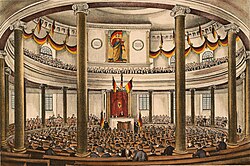
Back Germania (Paulskirche) German जर्मेनिया Hindi Germania (festmény) Hungarian Germania (Paulskirche) Italian Germania (Sint-Paulskerk) Dutch «Germania» (maleri) NB Germania (Kościół Świętego Pawła we Frankfurcie nad Menem) Polish Germania (painting) SIMPLE


Germania is the name of a painting that was probably created in March 1848. It hung in the St. Paul's Church (Paulskirche) in Frankfurt, Germany. At that time, first the so-called Pre-Parliament and then the Frankfurt National Assembly, the first all-German parliament, met there. The National Assembly was a popular motif of the time, so the Germania painting also became very well-known. After the National Assembly was violently terminated in May 1849, the painting was taken down. In 1867 it was moved to the German National Museum in Nuremberg.
The painting is one of the best-known representations of Germania, a woman who stands for Germany. Such a national allegory also exists in other countries. The motif was often taken up during the time of the emerging German Empire 1848/1849 and later.[1]
- ^ Rainer Schoch: "Streit um Germania. Bemerkungen zur 'Germania' aus der Paulskirche". In: Germanisches Nationalmuseum (ed.): 1848: Das Europa der Bilder. Volume II: Michels März. Nuremberg: Germanisches Nationalmuseum, 1998, pp. 89–102, see p. 99.